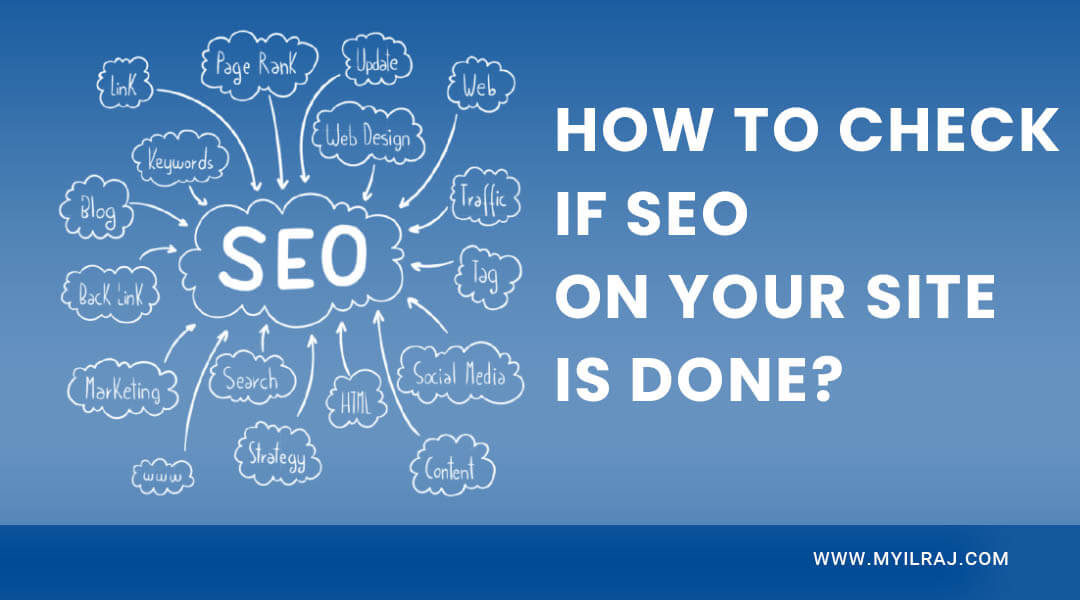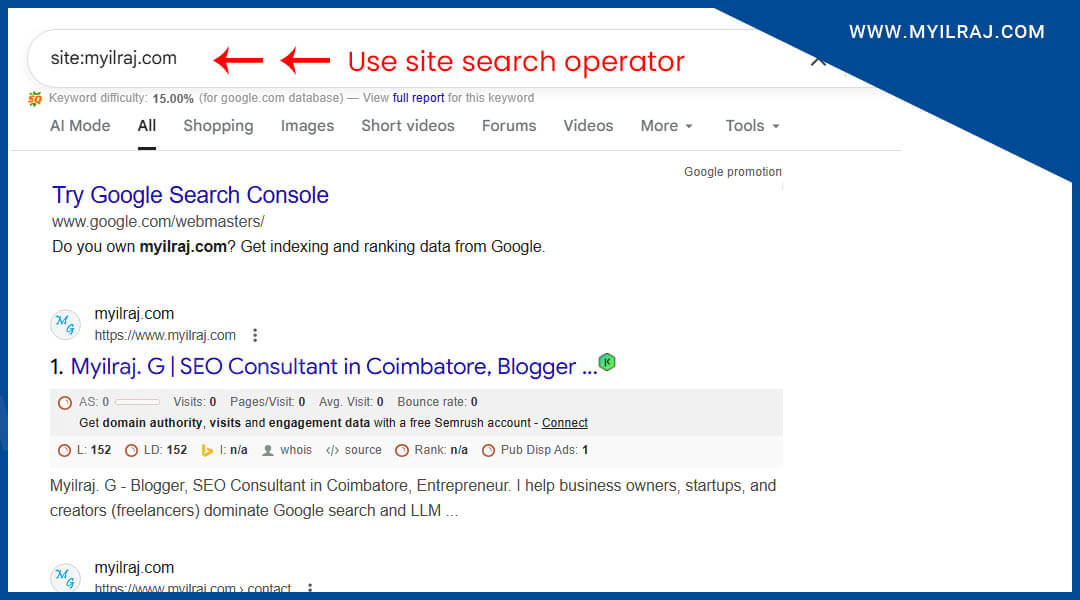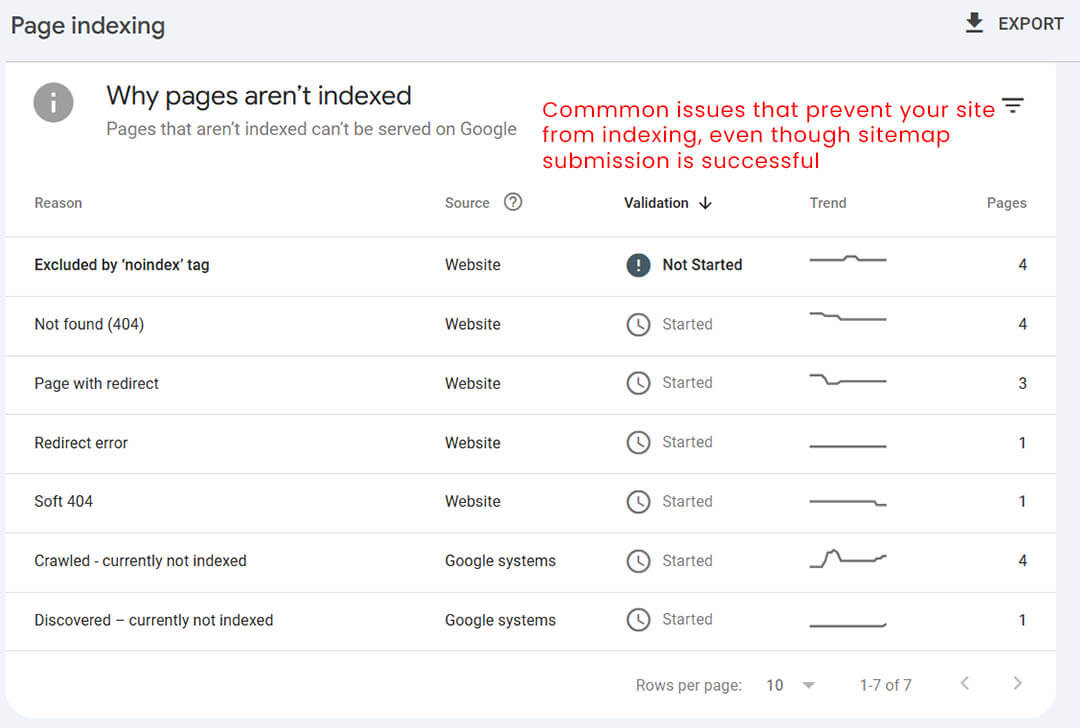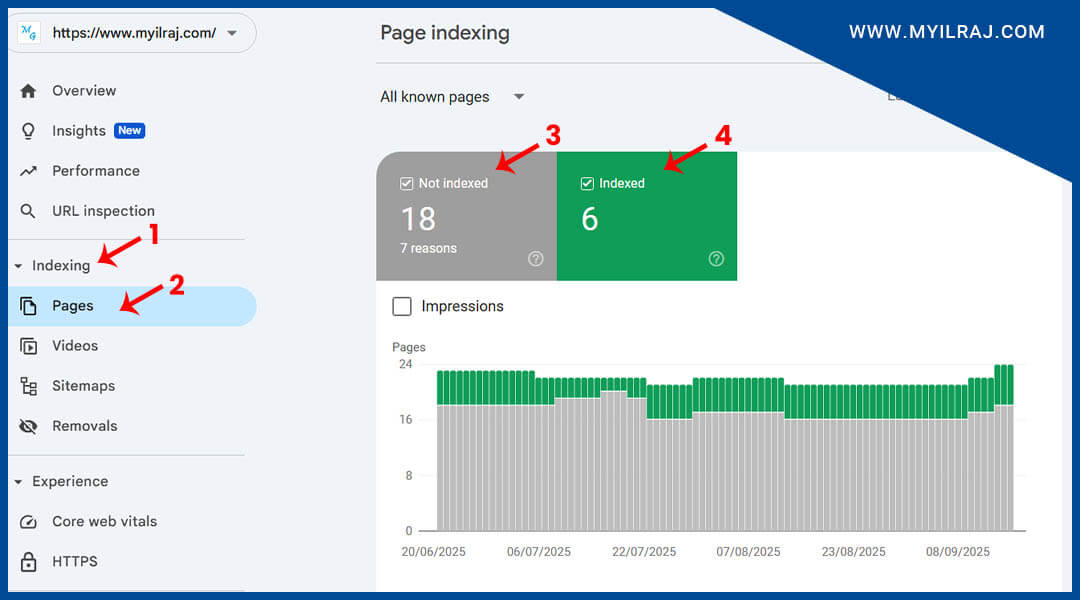Have you ever wondered if SEO is done on your website?
This is one of the common questions I used to hear from business owners, founders, and bloggers.
The truth is, SEO is not a one-time activity. It is not like building a website, checking all boxes, and then leaving it.
Search engine optimization is a continuous process of fine-tuning your website. Because our website needs to be relevant, competitive in search results, and must stay visible for a long time.

Here’s why SEO is important for every website.
- Google updates its algorithms several times every year.
- Competitors are constantly improving their websites by doing SEO.
- The user expects fast loading, mobile-friendly, and valuable content.
So, now you may ask How do I check if SEO is done on my site? It is a very simple process, and all you need is a systematic way to audit your site.
Doing an SEO audit helps you to check what’s working, what’s missing, and what needs fixing.
In this article, I will walk you through the step-by-step SEO health check. It includes on-page factors, technical SEO, content quality, backlinks, schema, and AI readiness.
At the end, you will exactly learn how to measure your SEO efforts. Also, you will know when it is time to hire professional help, like hiring an SEO consultant in Coimbatore who does this every day.
Understanding the Basics of SEO
What most people nowadays know about SEO is “adding keywords” or “building backlinks.” Yes, these activities are a part of SEO, but they only work on the surface.
The real SEO in 2025 is around the four core pillars. We will read them below.
SEO (Search Engine Optimization) is about making your website discoverable, relevant, and trustworthy in the eyes of search engines, AI, and human users.
It is broadly classified into four layers:
On-Page SEO: optimizing content, titles, descriptions, headings, images, and links.
Off-Page SEO: building authority with backlinks, social signals, and brand mentions.
Technical SEO: ensuring your site is loading faster, mobile-friendly, crawlable, and secure.
AI SEO: making your site the best choice for AI pickups and citations.
Common Misconceptions About SEO
Is SEO “done once” or a continuous process?
The biggest mistake that I see as an SEO consultant in Coimbatore is when businesses treat SEO like a “project to finish within a time frame.”
They think that once their website is optimized with the four layers mentioned above, the job is done.
After a few months, they wonder why their website rankings have fallen and search for how to check if SEO is done on their website.
They never understand that SEO is a continuous cycle of optimizing, updating, monitoring, and improving.
New-Age SEO – AI SEO, SXO, and Beyond
A few years back, SEO was primarily about adding keywords in the content.
But today, it is about experience and adaptability. SEO has evolved, and it is beyond just ranking your website.
Here’s why I strongly justify it;
i. AI SEO – Google’s recent Search Generative Experience (SGE) and AI-driven overviews, your content must be structured well and contextual enough to be picked up by AI.
You need to write clear answers with semantically related keywords and authoritative content.
ii. SXO (Search Experience Optimization) – Google does not just look at the “keyword placements,” it wants the best user experience.
The websites that provide smooth navigation, fast loading, and fulfill user search intent are rewarded.
iii. Voice & Conversational Search – Users these days are searching by voice, asking full questions.
Therefore, we need to optimize our content for natural language queries to get better organic visibility.
Why Our Website Needs Regular SEO Audits?
As humans, we usually care for our bodies and maintain our health. We will not visit the doctor only once and declare that we are healthy forever.
We might need regular health check-ups. Similarly, regular SEO audits help you catch indexing issues, technical errors, or content gaps that hinder your organic growth.
If you have just launched your website, learn the crucial steps for SEO for new websites. This checklist ensures that your website is built on a solid foundation from day one.
Let us learn the 6-step process on how to check if SEO is done on your website or not.
Step 1 – Check Indexing Status
What To Check Here?
- Google site index
- Sitemap submission
- Common Indexing Issues
Before you jump into analyzing your website rankings, backlinks, or even content quality, you must first check your indexing status.
- Is your website indexed by Google?
If the pages are not indexed by Google, they will not show in the search results (no matter how well you optimized the website and content).
Let me share a few ways to complete the first step in checking website SEO status.
Use the site:domain.com Search Operator
It is the quickest way to check whether Google knows that you exist on the Internet.
Go to Google.com > type site:myilraj.com (replace your domain name) > hit enter.
Now, observe the results.

If you see 0 results, your site is not indexed at all (it means Google didn’t know you exist on the Internet).
Also, check the number of pages indexed that match the URLs in the sitemap.
Recently, I audited an education niche website with 250+ blog posts. However, Google site search shows only 135 blogs. All other blogs are hidden from the search.
Verify Sitemap Submission in Google Search Console
It is a free tool by Google to monitor your website performance.
- Log in to Google Search Console (GSC).
- Go to Indexing > sitemaps.

Make sure that you have submitted a sitemap and processed it without errors.
If there is no sitemap, create one with the help of an external sitemap generator and submit it.
Today, most websites are developed on WordPress integrated with SEO plugins (like Yoast, RankMath, etc.).
These plugins generate XML sitemaps by default. If you are looking for a WordPress website developer in Coimbatore, contact me.
Common Indexing Issues to Watch For
If the sitemap submission status is showing success, watch out for hidden issues.
Let me share them below;
- Noindex Tags
- Blocked by Robots.txt
- Canonical Errors
- Crawl Budget Wastage
- Meta Robots Tags

How to check these hidden issues?
Inside Google Search Console, go to indexing > pages.
Here you will see three statuses: Indexed and Not-indexed.

These reports give you a detailed breakdown of what’s really happening.
Step 2 – On-Page SEO Checks
What To Check Here?
- Meta Title & Meta Description
- Header Tags (H1 to H6)
- Keyword Placements
- Image SEO (with Alt Tag)
- Internal Linking
On-page SEO is all about optimizing the website and its webpages.
You will have complete control over your website’s content, structure, and HTML tags.
Just imagine you are painting your home after a few years of our housewarming function.
Title Tags & Meta Descriptions
Your title tag is the first thing users and search engines see.
It should be.
- Unique with the primary target keyword.
- Under 60 characters.
- Descriptive, curious triggering.
To learn more about optimizing meta-titles, visit my blog post at onlinehomeincome.in blog.

Next, the meta description (short summary of our article) is displayed next to the title tag.
It should be:
- Short, but descriptive and persuasive.
- Must include primary KW and LSI or Long-tail KW.
- Under 145 – 160 characters.
Meta descriptions do not directly impact your search rankings, but help improve click-through rates (CTR).
Proper Header Hierarchy (H1–H6)
Header tags are like signboards in your office building that guide visitors, and here, they help Google as well.
Here are the conditions;
- Add one header tag every 250 words.
- There must be at least one H1 per page.
- Use H2 to H6 to break down content sections.
- Natural includes keywords and related terms.
Keyword Placement Without Stuffing
A few years ago, Google ranked content based on the number of keywords.
But these days, Google bots and AI learn from our content and understand the context before recommending it to the users.
However, Keywords still play a crucial role in SEO.
Here are the conditions;
- Place your primary keyword in the title, intro, conclusion, and in a few headers.
- Use LSI keywords throughout the content to avoid keyword stuffing.
- Always write for humans and then optimize for search engines and LLM.
Read my blog post at onlinehomeincome.in about keyword placements and how to use LSI keywords to rank higher.
Image SEO (Alt Text + Compression)
Visuals get more attention than long-form text. Every blog post must have a few media elements like images, pictures, GIFs, and videos.
Also, you must help bots understand the image context.
Every media element must have;
- Alt text describing the image (helps SEO + indexability).
- Compress the image size to load faster.
- Write descriptive file names instead of random characters.
Internal Linking Strategy
Internal links play a crucial role in improving our website’s authority. It acts like a bridge that connects our website content (pages and blogs).
Strategic linking helps Google understand your site structure and distribute the page authority.
Here’s what you must do;
- Link related blogs from one another.
- Use descriptive anchor text.
- Do not use words like “click here,” “read more,” etc.
Create a link tree and place the cornerstone article at the top.
You can use tools like Yoast, RankMath, and Surfer SEO for internal linking. I am using Link Whisper for strategic internal linking.
Key Takeaway:
On-Page SEO is not about tricks. It is purely about bringing clarity and value to the table.
When you optimize the On-Page elements on your website properly, Google and AI see your page as organized, helpful, and trustworthy.
Step 3 – Off-Page SEO Audit (Build Authority)
What To Check Here
- Total Backlinks
- Competitor Backlinks
- Social Signals
The next big factor that decides your ranking is off-page SEO. It is like your website’s reputation on the Internet.
Google evaluates your website’s authority through backlinks, brand mentions, and social media signals.
- On-Page SEO ensures your website is technically sound and user-friendly.
- Whereas, Off-Page SEO tells Google whether you and your website are trustworthy.
You can build that trust by creating backlinks from authoritative websites, positive brand mentions, and a strong social media presence.
So how can you do this?
Start building backlinks:
Check your backlink profile using tools like SEMrush, Ahrefs, or Google Search Console.
Look at these factors like Domain Authority, Trust Flow, Citation Flow, and toxic backlinks.
Start building quality backlinks by doing Guest Blogging, Link Outreach, and looking out for Brand Mentions.
For local businesses, maintaining consistent NAP citations across directories builds credibility.
Perform Competitor Backlink Analysis:
Using the same SEO tool, analyze your competitor’s websites and create a list of their backlinks.
If they are featured on niche blogs, directories, or media sites, aim to get placements from the same area.
Social Signals:
Social media may not directly impact rankings, but active social media profiles create trust signals.
Social media drives real people to your website.
It will give you more visibility = more chances of people linking back to you.
Why Backlinks Still Matter in 2025?
If content is the heart of SEO, backlinks are its backbone. Every backlink is a vote of confidence that makes Google trust your website.
The more quality links pointing to your site, the higher your domain authority score is. Remember, backlinks are the primary ranking factor.
Also, pay attention when you choose the right SEO partner, be it a freelancer or an agency. Their activity and strategies greatly influence your backlinks and authority.
So, before reading further, explore the detailed comparison of Freelance SEO vs Agency SEO to make the best choice.
What are Quality Backlinks?
The backlinks below are considered good and helpful for ranking.
- Links from relevant niche websites or blogs.
- Local backlinks from relevant directories.
- PR and brand mentions build topic authority.
Easy Ways to Build Authoritative Backlinks in 2025
- Guest Posting – Write for other websites and blogs.
- HARO (Help A Reader Out) – Provide expert quotes to get featured in media.
- Local Citations – Add your business to Google My Business, Justdial, Trade India, etc.
- Content Assets – Republish blogs into infographics, PDFs, and case studies.
- Partnerships (& Networking) – Collaborate with relevant bloggers and industry peers.
For example, Someone wants to choose an SEO consultant and search for “SEO Consultant in Coimbatore.” Google doesn’t provide results based on the number of backlinks. It also looks for reviews, citations, and brand mentions across the web.
Step 4 – Technical SEO Checks
What To Check Here
- Mobile Responsiveness
- Page Loading Speed
- HTTPS (SSL Certificate)
- Crawl Errors
- Duplicate Content
- Canonical Tags
You have the best content, perfect keywords, and a pleasing design. But what if your website takes 10 seconds to load?
Customers, AI, and Google can’t see your website and its content.
Therefore, technical SEO optimization is essential for every website, and you need to focus on crawlability, security, user-friendliness, responsiveness, and fast loading.
Let us read those factors that require regular monitoring.
Mobile Responsiveness & User Experience
In 2025, more than 65% of people search through their mobile devices. If your website doesn’t fit those screens, you will lose both rankings and customers.
Conduct a Google mobile-friendly test regularly to check if your website is responsive and loads quickly.
Make sure every button is clickable, text is readable, and no elements break on smaller screens.
Page Speed & Core Web Vitals (LCP, CLS, INP)
Leverage the Google page insights tool to check the following speed factors.
LCP (Largest Contentful Paint): It should be under 2.5seconds.
FID (First Input Delay): It should be under 100ms.
CLS (Cumulative Layout Shift): Ensure the page elements do not shake during loading.
You can use other tools like GTMetrix, Pingdom Tools, and Web Page Test.
HTTPS & SSL Security
Nowadays, every website must have an active SSL certificate, and it is a rule set by Google. Most web hosting providers give away free SSL with their hosting plans.
You can check our company’s (Raj Softech Solutions) shared hosting plans here. Ensure that you have added proper redirection code in your .htaccess file and redirect every request to the “HTTPS” version.
Crawl Errors & Fixes via Search Console
Can you remember the indexing issues that we discussed a few seconds ago? It falls under Technical SEO.
Go to GSC > Pages.

Observe all crawl errors, like;
- Server errors (5xx)
- Not found (404)
- Blocked by robots.txt
- Crawled, but not indexed
- Discovered, but not indexed
These errors should be fixed promptly and monitored from time to time to save crawl bandwidth.
Duplicate Content & Canonical Tags
Sometimes, we may accidentally create multiple pages for a small keyword variation.
For example,
Think your website has http://example.com/this-post and https://example.com/this-post/.
Google gets confused in deciding which URL to index.
Therefore, you must use Canonical tags to tell Google which version of the URL needs to be indexed. Also, ensure every URL has a primary keyword for better ranking.
Always keep your site clean and logically structured with breadcrumbs for better navigation.
Key Takeaway:
Technical SEO is like the foundation of your building.
Without it, even the most beautifully decorated interior (it means your content) will not be considered.
Google, AI, and People won’t step inside.
Step 5 – Content Quality Review
What To Check Here
- EEAT Score
- Helpful Content Guidelines
- Thin Content
- Duplicate Content
- Matching User Search Intent
If you have created a beautiful WordPress website that loads faster and is responsive on mobile devices, it means nothing if the content is poor.
Quality content remains the most powerful ranking factor in the past, in the present, and in the future, too.
Google algorithms (after Helpful Content Update) rewards only laser-focused content that provide genuine value, authority, and relevance.
So how can you validate it?
Follow the EEAT Framework.
Google uses the E-E-A-T framework (Experience, Expertise, Authoritativeness, Trustworthiness) to assess content credibility.
- Experience: Do you have enough tried-and-tested experience on the subject (e.g., case studies, personal insights, practical examples).
- Expertise: Are you a subject matter expert in the relevant field?
- Authoritativeness: Does your brand have recognition in the niche? (e.g, citations, backlinks, PR mentions).
- Trustworthiness: Is your content and its message accurate and well-cited (e.g., author bios, credentials, and social references).
Avoid thin content (pages with repetitive titles, information, often <600 words are considered as thin content).
Avoid duplicate content (copy-pasting across multiple pages or from different websites).
Make sure you match the user search intent.
For example, if your blog is targeting an informational keyword, but you write content like a sales page, you will lose relevance.
In short, high-quality, authoritative content builds trust with readers, Google, and AI bots. Without it, just focusing on keywords will not last for a long time.
Step 6 – Measuring SEO Results
SEO without monitoring and measuring results is driving blindfolded. You will never know whether your efforts are worth paying off.
Whenever I consult businesses in Coimbatore, the first thing I ask is:
- How are you measuring your SEO success right now?
Unfortunately, most Coimbatore business owners never track, but only worry about rankings.
Let me tell you how to measure SEO effectiveness.
Step 01: Set up Google Search Console (to track impressions, clicks, CTR, indexing issues, and average position).
Step 02: Set up Google Analytics (to monitor traffic sources, user behavior, and conversions).
Step 03: Keyword Tracking Tools (Ahrefs, SEMrush, etc., to monitor keyword rankings).
What to Measure Beyond Rankings (Important SEO KPIs)?
SEO success does not end when you see your website on page 01. It is something beyond that.
- Organic Traffic Growth – Are more new people discovering your site every month?
- Keyword Distribution – Is your website ranking for more keywords?
- Click-Through Rate – Do your meta-titles and descriptions convince users to click?
- Engagement Metrics – Pay attention to bounce rate, time on page, and scroll depth.
- Conversions – Are visitors filling forms, booking calls, or buying products?
In the end, SEO is not about driving more traffic to your website. It is about business results and how many sales you bring to the table every day.
Bonus – Advanced SEO Checks
As I said earlier, SEO is not about keywords and content. Nowadays, we need to explore more advanced SEO techniques to not just rank, but to deliver the best user experience.
Google’s AI systems like RankBrain, BERT, and Gemini are designed to understand intent. If our content doesn’t answer directly and clearly, we will be removed from the competition.
Here are a few advanced SEO tips on how to check if SEO is done or not.
AI + SEO (AI-driven search)
Stop Keyword stuffing and build topical authority. Write naturally and in a conversational tone that helps someone.
Implement structured schema markup to make it easier for AI systems to feature your site in their search engine results. Don’t forget FAQs and Carousels.
GEO SEO (Local Search Optimization)
GEO signals are a critical SEO factor, and they must be included in your SEO audit checklist.
For businesses in Coimbatore (or any local market);
- Create a Google Business Profile.
- Ensure NAP consistency across other directories.
- Collect reviews
- Add location-based schema and keywords.
This is especially important for service-based businesses that rely on leads from the local community.
Local search optimization delivers more relevant leads. Discover effective local search optimization strategies designed for Coimbatore entrepreneurs.
SXO (Search Experience Optimization)
SXO is about SEO + UX (user experience). Google rewards websites that not only get clicks but also satisfy user intent.
Some keyword factors are;
- Fast-loading pages.
- Mobile-first, responsive designs.
- Clear navigation and internal linking.
- Interactive content (videos, FAQs).
If someone lands on your page and finds everything they need, then SXO is done right.
Conclusion – Why SEO is Never Truly “Done”
So, is SEO on your site really “done”?
The honest answer: No.
SEO is a continuous process that involves regular auditing, improvement, and adaptation to evolving needs. Search engines, AI algorithms, and user behaviors keep evolving.
In this article, I have covered everything from indexing checks, on-page and technical SEO fixes, content quality checks, etc.
Not only that, I have explained about auditing backlinks, implementing advanced strategies like AI SEO, GEO SEO, and SXO.
I also taught you how to measure your SEO results using various tools and checklists.
Each step helps you build a strong website that doesn’t just rank, but also attract, engage, and convert readers.
Remember,
- If your website is not indexed, it’s invisible.
- Writing content without user intent won’t rank.
- Backlinks without authority push you down.
- SEO measurement is not just guesswork.
If you are a business owner, startup founder, or blogger in Coimbatore, here’s the takeaway.
SEO is not at all an expense. It is your valuable asset when done right, compounds over time, and delivers sustainable growth and business.
So, What’s Next?
If you are unsure whether SEO on your site is truly complete, or if you feel stuck in ranking, or don’t know how to check if SEO is done, I can help.
I specialize in Organic SEO, Advanced AI SEO, and GEN SEO, where I make your website visible, trustworthy, and profitable.
Reach me via WhatsApp now to discuss further.
FAQ on How To Check If SEO is Done or Not?
First, start by checking whether your site is indexed in Google by using the site:yourdomain.com search. After that, examine common SEO issues like missing meta titles, descriptions, mobile-friendliness, page speed, and backlinks. You can also use tools like Google Search Console to give a more in-depth and comprehensive SEO report.
Yes, regular SEO audits help you find technical errors, broken links, duplicate content, or slow-loading pages. These issues directly affect your website’s search engine ranking and user experience. Therefore, regular monitoring makes your website adapt to evolving Google SEO guidelines.
On-Page SEO, Off-Page SEO, and Technical SEO are the three core SEO types.
On-Page SEO involves optimizing titles, headings, keywords, and internal linking. Off-Page SEO includes the process of building backlinks and brand mentions to increase domain authority. Technical SEO means improving crawlability, site structure, speed, and mobile optimization.
First, check your content for targeted keywords, proper headings, and descriptions. Then make sure the webpage has a clean structure and provides clear value to the readers. You can use tools like Yoast or Rank Math to measure the content optimization score.
You can perform basic checks like indexing, on-page optimization, and page speed on your own. But with basic knowledge, you cannot do competitive analysis, content analysis, a comprehensive audit, and create advanced strategies, which require an SEO expert.
